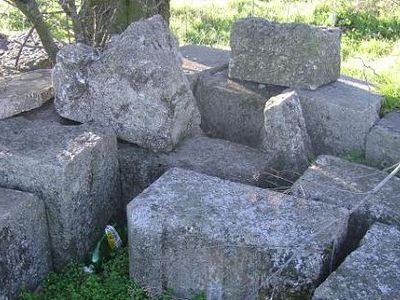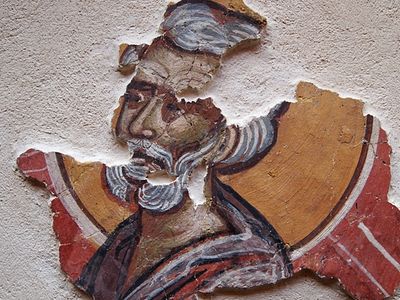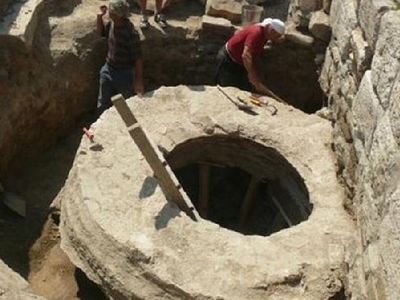Source: Archaeology in Bulgaria
January 14, 2016
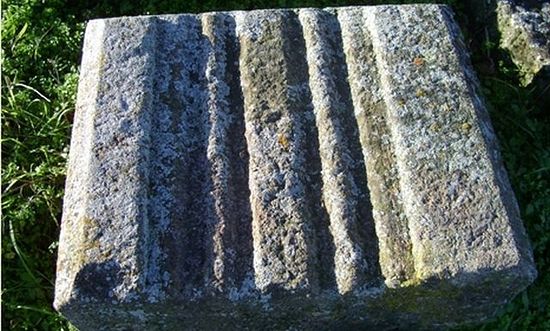 A stone from the Great Basilica in Pliska with its typical decoration is seen lying around at the defunct train station in Kamenyak. Photo: National Museum of History
A stone from the Great Basilica in Pliska with its typical decoration is seen lying around at the defunct train station in Kamenyak. Photo: National Museum of History
The archaeological restoration of the 9th century Great Basilica in Bulgaria’s Pliska, capital of the First Bulgarian Empire between 680 and 893 AD, will be continued used moreauthentic construction material that was removed from the temple by the Ottoman Empire in the 19th century to be employed for railway construction.
In December 2015, archaeologists and restorers from Bulgaria’s National Museum of History in Sofia, which is working on the restoration of the Great Basilica in Pliska, Europe’s largest temple until the 16th century, visited railway stations in Northeast Bulgaria.
They identified authentic stones from the Great Basilica that were used by the Ottoman Turkish authorities in the 1860s for the construction of train stations along the Ruse-Varna Railway, with some of the material going unused and still lying around some 150 years later.
The Museum has approached Bulgaria’s Transport Ministrywhich has now granted it a permission to use all original stonesfrom the 9th century Christian temple that have been found indefunct railway infrastructure from the second half of the 19thcentury.
The final destruction of the 102.5-meter-long basilica in Pliskatook place in the 1860s under Midhat Pasha, Governor of theDanube Vilayet (Province) of the Ottoman Empire, during theconstruction of the Ruse-Varna Railway.
Bulgaria’s Transport Minister Ivaylo Moskovski has agreed to support the restoration of the huge Christian temple by “donating" the original material extracted by the Ottomans to built train stations, water towers, and railway storage depots.
Some of the original material has been found at the operational train stations of Kaspichan and Hitrino, and the abandoned train station of Kamenyak.
 The now defunct Kamenyak train station in Northeast Bulgaria which was built by the Ottomans with materials extracted from the Great Basilica and other medieval Bulgarian archaeological monuments in Pliska and Veliki Preslav. Photo: National Museum of History
The now defunct Kamenyak train station in Northeast Bulgaria which was built by the Ottomans with materials extracted from the Great Basilica and other medieval Bulgarian archaeological monuments in Pliska and Veliki Preslav. Photo: National Museum of History
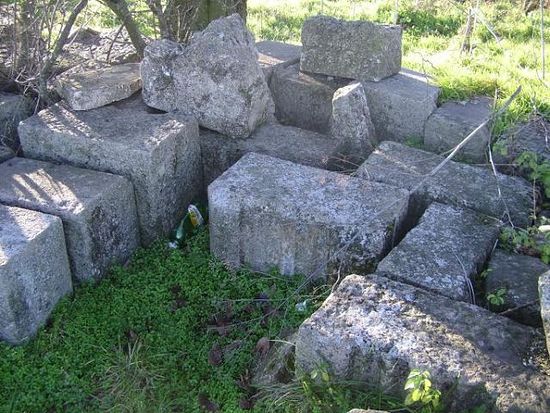 Stones from the 9th century AD Great Basilica in the then Bulgarian capital Pliska which were removed from the building in the 19th century by the Ottoman Turks but were left over from the Ottoman railway construction efforts can still be seen lying around the abandoned Kamenyak train station in Northeast Bulgaria. Photo: National Museum of History
Stones from the 9th century AD Great Basilica in the then Bulgarian capital Pliska which were removed from the building in the 19th century by the Ottoman Turks but were left over from the Ottoman railway construction efforts can still be seen lying around the abandoned Kamenyak train station in Northeast Bulgaria. Photo: National Museum of History
 The Hitrino train station in Northeast Bulgaria. Its first floor was built in the 19th century, still in the Ottoman period, with materials from the archaeological monuments in the medieval Bulgarian capitals Pliska and Preslav. Photo: National Museum of History
The Hitrino train station in Northeast Bulgaria. Its first floor was built in the 19th century, still in the Ottoman period, with materials from the archaeological monuments in the medieval Bulgarian capitals Pliska and Preslav. Photo: National Museum of History
The restorers have have already started using surviving original stones for the reconstruction of the basilica that they found lying around on the spot of the archaeological monuments in Pliska, the once glorious capital of the Ancient Bulgars which today is a tiny town.
The National Museum of History in Sofia has also announced that the Mayor of Hitrino Municipality, Nuredin Nuredin, has already given the restorers original stones from the basilica, of which the municipal authorities were in possession.
“The use of authentic material is recommendable as part of the intensifying restoration of ancient fortresses and temples across Europe," the Museum notes in its statement.
The Great Basilica in Pliska, the first capital of the First Bulgarian Empire (632/680-1018 AD) south of the Danube, was destroyed by the Ottoman Turks at the end of the 14th century even though part of its ruins are known to have survived until the 1860s when the Ottoman Empire built its first railway line connecting the Bulgarian cities of Varna on the Black Sea, and Ruse on the Danube.
The Ottoman authorities are known to have used construction materials from the basilica and other marvelous Bulgarian archaeological monuments in Pliska and Veliki Preslav, another early medieval Bulgarian capital, not only for railway construction but also for building military barracks and mosques.
The basilica was built between 865 and 875 AD, under Knyaz Boris I (r. 852-889; 893 AD), after the First Bulgarian Empire adopted Christianity in 864-865 AD.
It was constructed using huge rectangular limestone blocks (“quadras"). Each of these blocks weighed 300-400 kg, and each of them was processed individually to produce rectangular cuboids.
In addition to reusing original stone blocks in the restoration, the restorers also employ new limestone blocks that have been mined at a quarry near the town of Mezdra in Northwest Bulgaria.
The limestone from Mezdra is said to be completely identical with the original material used for the construction of the Great Basilica in Pliska, which was derived from several quarries in what is today Northeast Bulgaria back in the 9th century AD.
The Great Basilica in Pliska was 102.5 meters long and 30 meters wide, which means it was 20 meters longer than theHagia Sophia Cathedral in Constantinople, the titular temple of the Ecumenical Patriarchate during the period of theByzantine Empire, and several meters longer than the Old St. Peter’s Basilica in Rome (the predecessor of today’s St. Peter’s Cathedral).
It was modeled after the Old St. Peter’s Basilica in Rome, which was torn down in the 15th century AD in order to build the new St. Peter’s Cathedral.
The modeling of the Great Basilica in Pliska after the Old St. Peter’s Basilica in Rome may have to do with the role of Bishop Formosus (later Pope Formosus, r. 891-896 AD), an envoy of Pope Nicolas I (r. 858-867 AD) in the years after the First Bulgarian Empire formally adopted Christianity in 865 AD; it was in this period that the two medieval Christian centers, Rome and Constantinople battled for supremacy over the Bulgarian Church.
On May 2, 2015, when Bulgaria celebrated formally the 1150th anniversary since the adoption of Christianity, the ruins of the Great Basilica in Pliska saw the temple’s first Christian service since the Middle Ages. After the celebrations the Bulgarian Cabinet allocated BGN 500,000 (app. EUR 250,000) for further archaeological excavationsand partial restoration of the Great Basilica.
The renewed excavations have yielded results with the reaching of what has turned out to be a symbolic grave of Bulgaria’s first Christian martyr, St. Prince Boyan Enravota, and the reaching of water in the holy well of the Great Basilica.
The Great Basilica in Pliska is being rebuilt according to a project created in the 1980s by late architect Teofil Teofilovwhich is said to have been updated by architect Yuliy Farkov (who has become somewhat controversial because of his work on some highly criticized archaeological restorations).
Background Infonotes:
Pliska and Veliki Preslav (Great Preslav) are two of the capitals of the First Bulgarian Empire. Pliska was the capital of the First Bulgarian Empire in 680-893 AD, and Veliki Preslav in 893-970 AD, at the height of the Bulgarianstate. The state capital was moved from Pliska to Veliki Preslav, a new medieval city nearby, in 893 AD in order to seal Bulgaria’s adoption of Christianity and the Bulgarian (Slavic, Cyrillic) script (in 865 and 886 AD, respectively). The ruins of both Pliska and Veliki Preslav can be seen today in the Shumen District in Northeast Bulgaria.
The Great Basilica “St. Sofia" in the city of Pliska, capital of the First Bulgarian Empire between 680 and 893 AD, was built between 866 and 875 AD, after Bulgaria’s adoption of Christianity as the official state religions in 865 AD under Knyaz Boris I Mihail (r. 852-889; 893 AD).
The Great Basilica in Pliska, the first capital of Bulgaria south of the Danube, was the largest Christian cathedral in Europe in the Middle Ages. It was 102.5 meters long and 30 meters wide, which means it was 20 meters longer than the Hagia Sophia Cathedral in Constantinople, the titular temple of the Ecumenical Patriarchate during the period of the Byzantine Empire, and about 30 meters longer than the Old St. Peter’s Basilica in Rome (the predecessor of today’s St. Peter’s Cathedral). Thus, the Great Basilica in Bulgaria’s Pliska was technically the largest Christian temple in Europe until the 17th century, i.e. until the completion of the Papal Basilica of St. Peter in the Vatican in 1629 AD.
The Great Basilica in Pliska was built with huge white limestone quadras from the quarries in the nearby town of Kyulevcha. Around the basilica there was a large monastery complex and the residence of the Bulgarian Archbishop (between 870 and 917 AD), and the Bulgarian Patriarch (from 917 AD onwards). In this monastery complex, Bulgarian archaeologists have found a scriptorium for the “production" of medieval books in Old Bulgarian, also known as Church Slavonic. As Bulgaria’s National Museum of History points out, “it is with these books that the monasterymonks and missionaries converted [to Christianity] the peoples of modern-day countries Russia, Ukraine, Belarus, Romania, Moldova, Serbia in the 9th-10th century."
The Great Basilica in Pliska was still standing until the Late Middle Ages but was razed to the ground by the Ottoman Turks after their invasion at the end of the 14th century, and in the 15th century, because according to the laws of the Islamic Ottoman Empire no Christian temple could stand taller than a Muslim man mounted on a horse. The construction material from the unique buildings in Pliska was used by the Ottomans for the construction of the Turkish military barracks and the Tombul Mosque in the nearby city of Shumen, and whatever had been left of it by the 19th century – for the construction of the Varna-Ruse railway in 1866 under Ottoman governor Midhat Pasha.
Bulgaria’s adoption of Christianity as the formal and only state religion took place in 864-865 AD under the leadership of Khan / Knyaz Boris I Mihail (r. 852-889; 893 AD).
As a result of the successful reigns of Khan (or Kanas) Krum (r. 803-814 AD), Khan (Kanas) Omurtag (r. 814-831 AD), Khan (Kanas) Malamir (r. 831-836), and Khan (Kanas) Presian (r. 836-852 AD), by the middle of the 9th century the First Bulgarian Empire had become a huge empire spanning from the Black Sea in the east to the Adriatic Sea in the west, and from the Northern Carpathian Mountains in the north to the Aegean Sea in the south, including the entire or part of the territory of modern-day Bulgaria, Romania, Serbia, Greece, Turkey, Albania, Macedonia, Hungary, Moldova, and Ukraine. However, the major peoples inhabiting the Bulgarian Empire – the Ancient Bulgars (whose religion is known as tengriism) and the Slavs as well as the local Thracian population and others – worshipped different gods according to their own religions and mythologies. This was true even though there were entire areas in the then Bulgarian Empire which had been Christianized in earlier periods, and even though the first Khans from the House of Dulo are believed to have been Christians who were baptized by the imperial court of the Eastern Roman Empire, i.e. Byzantium: Khan (Kanas) Kubrat (r. ca. 630-ca.660) who founded the so called Old Great Bulgaria in 632 AD on the territory of much of modern-day Ukraine and Southwest Russia; Khan (Kanas) Asparuh (r. ca. 680-700)who expanded the state to the southwest technically creating modern-day Danube Bulgaria around 680 AD; andKhan (Kanas) Tervel (r. 700-718/721) who saved Europe from an Arab invasion during the siege of Constantinople in 717 AD. This led Khan Boris I to decide to unite the different ethnicities in the First Bulgarian Empire with a new common religion, and to pick Christianity (even though the adoption of Islam and Judaism were also offered to him by foreign emissaries) because Bulgaria was then the only still pagan major European power, and he wanted Bulgaria to be treated as an equal by the Byzantine Empire in the east and the successors of the Frankish Empire in the west.
While Khan Boris I initially intended to adopt the Western form of Christianity from the Pope in Rome via the Kingdom of the East Franks (East Francia in modern-day Germany) because Byzantium had been Bulgaria’s major geopolitical foe, he was forced to change his decision after an unsuccessful war with the Byzantines imposed on him the adoption of the Eastern form of Christianity as part of a peace treaty signed in 863 AD. This resulted after the First Bulgarian Empire had had to fight simultaneously Byzantium in the southeast and Great Moravia in the northwest. Thus, in 863 or 864 AD, a mission from the Patriarch of Constantinople Photios came to Pliska and converted the Bulgarian Tsar, his family and high-ranking dignitaries, who were baptized as Christians. Khan Boris I became Knyaz Boris I Mihael – taking the name of his baptist, Byzantine Emperor Michael III (r. 842-867 AD), and in 865 AD there was baptism en masse of the entire Bulgarian population. Thus, even though the subsequent years saw the first major clashes between the Pope in Rome and the Ecumenical Patriarch in Constantinople over the “Bulgarian Question", i.e. whose diocese the large and powerful newly baptized First Bulgarian Empire should belong to, Bulgaria remained in the camp of Eastern Orthodox Christianity subsequently helping pass it on to later emerging nations such as Serbia and Russia, and thus modifying forever the history of Europe.
Bulgaria’s adoption of Christianity, however, went far from smoothly, and not only because of the clashes between the Pope in Rome and the Ecumenical Patriarch in Constantinople over whose diocese the newly converted Bulgarians should belong to. In 865, conservative Bulgar aristocrats from all 10 komitats (administrative regions) of the First Bulgarian Empire revolted against Boris, who now took the Christianized title of Knyaz (i.e. King) in order to restore the old religion, tengriism. Knyaz Boris I managed to suppress the revolt executing 52 Bulgarian boyars (heads of noble families). According to some sources, he also had their entire extended families executed. Until the end of his life, Knyaz Boris was haunted by guilt about the harshness of his measures and the moral price of his decision in 865. In his later correspondence with Pope Nicholas I, the Knyaz asked whether his actions had crossed the borders of Christian humility, for which the Pope offered forgiveness: “You have sinned rather because of zeal and lack of knowledge, than because of other vice. You receive forgiveness and grace and the benevolence of Christ, since penance has followed on your behalf."
Knyaz Boris realized that the Christianization of Bulgaria gave Byzantium great influence over the domestic affairs of the Bulgarian Empire. Thus, juggling the differences of Rome and Constantinople, he eventually managed to get Byzantium’s Ecumenical Patriarchate as well as the Pope in Rome to recognize an independent (autocephalous) Bulgarian Archbishopric, which was created in 870 AD in an unprecedented development for Europe because independent churches had been only those founded by Apostles or Apostles’ disciples. For example, the Papacy in Rome had been challenging Constantinople’s claim of equality to Rome on the grounds that the Church of Constantinople had not been founded by an Apostle of Jesus Christ. Nonetheless, this development was also a success for Byzantium, and during the decade after 870 AD, Pope Adrian II and his successors kept trying desperately to convince Bulgaria’s Knyaz Boris to leave Constantinople’s religious sphere.
Knyaz Boris I Mihail sealed the success of his deed, the adoption of Christianity, in 886 AD when Bulgaria welcomed the disciples of St. Cyril and St. Methodius, St. Kliment Ohridski and St. Naum Preslavski, helping them to teach thousands of Bulgarian clergymen to serve in Bulgarian. Thus, Bulgaria adopted the Bulgarian script, also known as the Slavic script – first the Glagolithic and then the Bulgarian (Cyrillic) alphabet. This allowed Knyaz Boris, and his successor Tsar Simeon I the Great to declare Bulgarian (also known as Old Bulgarian or Church Slavonic) as theofficial language of the Bulgarian Orthodox Church during the Council of Preslav in 893 AD (which also moved Bulgaria’s capital from Pliska to Veliki Preslav (Great Preslav)). As all over Europe religious services were held in the“official" church languages Latin and Greek, this “nationalization" of the liturgy language by Bulgaria becameanother exceptional development in medieval Europe after the recognition of the independent Bulgarian church.

